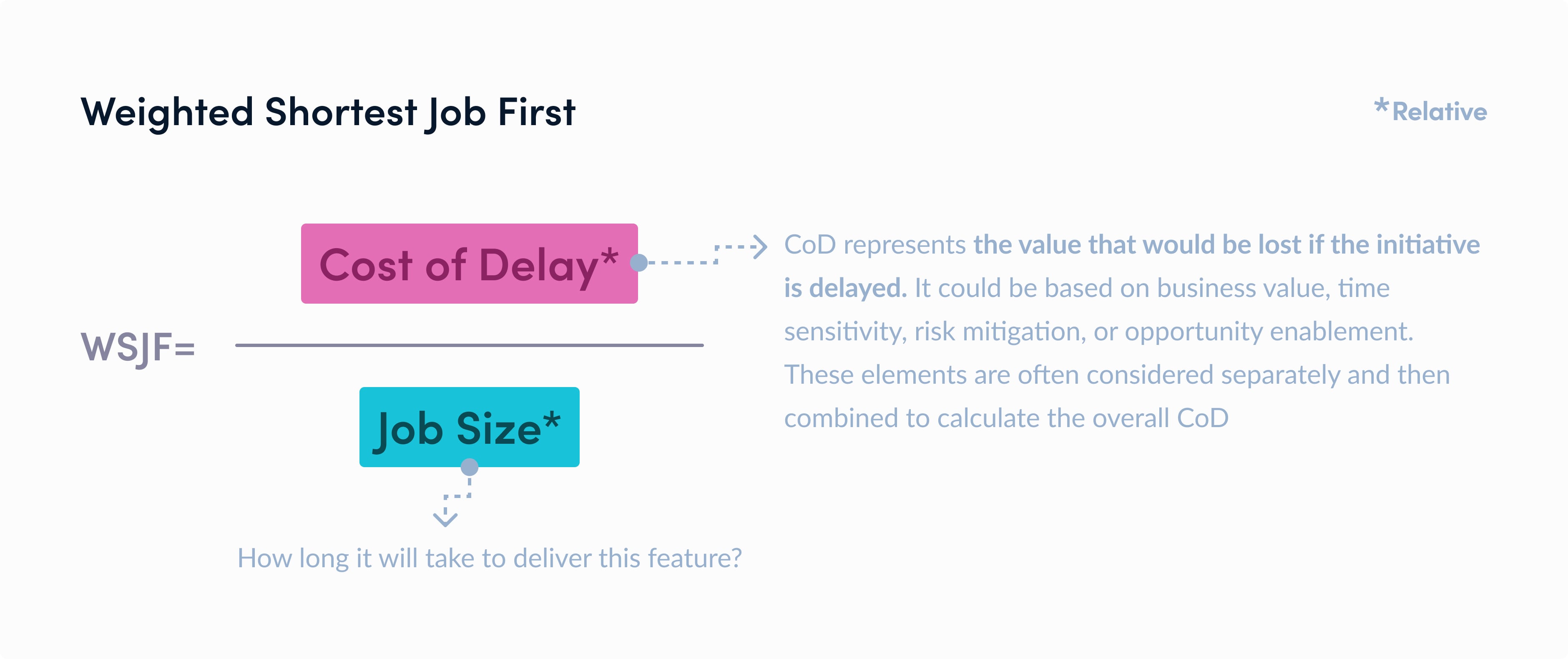Updated: January 3, 2025- 10 min read
In his book, The Principles of Product Development Flow, Don Reinertsen illuminates one key impediment in product development.
He observes that roughly 85% of product managers don't know the answer to the question, "What would it cost if we delayed this thing a few months?" Furthermore, he says the gut feeling we have about the answer usually misses the target. In fact, Product Managers' estimates can be very different.
So, we beg the question — is rubber-stamping the Cost of Delay causing serious losses? Should companies put extra effort into quantifying 'the total expected value with respect to time'? Lastly, can the Cost of Delay calculation help teams make better decisions?
In a nutshell — yes, yes, and yes. Now, let's crack open the details.
Product Feature Analysis Template
Understand how your Product’s features stack up to the competition. Identify core features needed to compete against industry-standard products. Then go above and beyond!
Get template
What Is Cost of Delay?
Cost of Delay (CoD) is a critical concept in Product Development and Product Management. It refers to the economic impact of delaying a project or product feature. Essentially, it's the money you lose by not having your product or feature available sooner. Think of it as the price tag for procrastination of your product launch.

To better understand the concept, suppose Company X plans to invest $600,000 at an expected annual interest rate of 15%, compounded yearly. The company needs these funds in 5 years.
If this investment gets delayed, Company X faces a Delay Cost, which varies with the length of the delay. For example, a 13-month delay could result in up to $97,500 in lost potential earnings.
CoD essentially quantifies the potential revenue, cost savings, or other benefits that are lost due to delays. By assigning a monetary value to the delay, businesses can better understand the urgency of completing certain tasks. This financial perspective is vital for making strategic decisions, especially when resources are limited, and multiple projects are competing for attention.
In essence, CoD allows companies to prioritize initiatives that will deliver the highest economic return in the shortest amount of time.
Why is Cost of Delay Important?
CoD is not just about lost revenue; it also encompasses various other financial implications. For instance, delaying a product launch might result in missed market opportunities, increased competition, or higher development costs due to extended timelines.
Additionally, it can affect customer satisfaction and brand reputation if the delayed feature or product is critical to the market. By quantifying these impacts, businesses can assess the true cost of their decisions and avoid unnecessary delays.
One of the key applications of CoD is in (1) feature prioritization within product development. When multiple features or projects are vying for development resources, CoD helps identify which ones should be tackled first. Features with a higher CoD should be prioritized because their delay would result in more significant financial losses.
In project management, CoD serves as a tool for optimizing schedules and resources. (2) Project managers can use CoD to identify critical tasks that, if delayed, would have the most significant impact on the project's overall value. This allows them to allocate resources more efficiently and ensure that high-impact tasks are completed on time. Furthermore, CoD can be used to justify investments in additional resources or process improvements that can help expedite critical tasks.
CoD is also invaluable for strategic planning at the executive level. By incorporating CoD into their decision-making processes, (3) executives can better align their strategies with the company's financial goals. It provides a clear, quantifiable basis for evaluating the potential impact of delays on overall business performance.
In conclusion, by understanding and applying CoD, organizations can minimize the financial impact of delays, optimize their development processes, and ultimately deliver more value to their customers and stakeholders by means of:
Prioritization: Understanding CoD helps you prioritize work more effectively. When you know the financial impact of delays, you can focus on tasks that should be completed first to maximize value.
Informed Decision-Making: CoD provides a concrete basis for making decisions. Instead of relying on intuition, you can use CoD assessments to guide your strategy and allocate resources more wisely.
Resource Optimization: By knowing the cost of delaying certain tasks, you can better allocate your team’s efforts and resources to where they will have the most significant impact.
Competitive Advantage: Being on time can be crucial, especially considering the exponential changes in technology. Understanding and minimizing CoD can give you a competitive edge by getting your products to market faster.
Applications of Cost of Delay
Feature Prioritization: Use CoD to decide which features to develop first and avoid feature creeps. Features with a higher CoD should typically be prioritized to maximize the overall value delivered by the project.
Project Management: CoD can help project managers allocate resources and time more effectively, ensuring that high-impact tasks are completed without unnecessary delays.
Product Launches: For product managers, understanding CoD is crucial when planning launch timelines. Delaying a product launch can significantly impact market share and revenue.
Strategic Planning: Executives can use CoD as a metric to guide tactical and strategic decisions. Having a plan in place ensures that the company focuses on initiatives that offer the highest return on investment.
Tips and Insights on Conducting Cost of Delay Analysis
Conducting a Cost of Delay (CoD) analysis can significantly enhance your decision-making process as a product manager. Here are some tips and insights to help you get started:
Understand the Impact: Begin by identifying how delays impact your product and business. Consider factors like lost revenue, customer dissatisfaction, competitive disadvantages, and increased costs. This broad understanding will guide your product analysis.
Gather Data: Collect relevant product data to support your analysis. This might include market research, sales projections, customer feedback, and historical data on similar projects. The more accurate your data, the more reliable your CoD analysis will be.
Engage Stakeholders: Involve key stakeholders from different departments such as marketing, sales, finance, and engineering. Their insights can provide a comprehensive view of the potential impacts of delays and help in estimating costs accurately.
Prioritize Features: Use CoD to prioritize features or tasks. Features with the highest CoD should be tackled first, as delaying them would result in the most significant financial losses. This helps in focusing on what matters most.
Iterate and Refine: CoD analysis is not a one-time activity. Continuously refine your calculations as new data and insights become available. Regular updates ensure that your decisions remain aligned with the current business environment.
In her webinar, How to Prioritize Your Product, Marie Uyecio, Product Leader at American Express, urges PMs to:
Consider breaking down your feature scope into smaller increments …instead of building a complex, large, almost unattainable point of arrival as your first release, as this will take more time, delaying any market launches…which will definitely drive up your cost of delay.
How to Calculate Cost of Delay
Once you have a good understanding of the basics, you can move on to the actual calculation. Here’s a step-by-step guide to help you understand the cost of delay formula and how to perform a cost of delay calculation:
1. Estimate the Value
Determine the financial value that the feature or product will bring once it’s available. This could be revenue, cost savings, or any other tangible benefit. For example, let’s say a new feature is expected to generate $600,000 in revenue over five years.
2. Determine the Time Frame
Identify the time period over which the value will be realized. In the example we shared above, it’s five years.
The point at which the value is realized is typically when the product or feature goes live and starts generating benefits — revenue or cost savings. This should be aligned with the expected duration over which these benefits will continue. It is not just the break-even point but the entire period during which the value is delivered. So, it's about when you start seeing value and how long that value lasts.
3. Calculate Daily Value
To find the daily value, divide the total estimated value by the number of days in the timeframe. There are 1,825 days in five years (365 days x 5 years).
Daily Value = Total Value ($600,000) % Number of Days (1,825 days) = $328.77 per day
4. Factor in the Interest Rate
Consider the interest rate to account for the time value of money. If the expected interest rate is 15% per year, you need to adjust your calculations accordingly. This can be done using present value or more complex financial models.
5. Apply the Formula
Multiply the daily value by the number of delay days to get the total cost of delay.
Cost of Delay = Daily Value × Delay Period (in days)
Using our example:
Cost of Delay = $328.77 x 396 = $130,002.12
So, delaying this investment by 13 months would cost Company X approximately $130,002.12 in lost revenue.
WSJF and Cost of Delay in Agile Projects

Weighted Shortest Job First (WSJF) is a prioritization technique used in Agile project management that helps teams decide which tasks to tackle first. It's one of the prioritization frameworks related to the concept of Cost of Delay, which is a crucial factor in determining the priority of tasks in Agile projects.
WSJF is calculated by dividing the Cost of Delay (CoD) by the job duration or the effort required to complete it. The formula is:
WSJF=Cost of Delay / Job Duration
The idea is to prioritize tasks that have the highest value and can be completed in the shortest time, thus maximizing the return on investment quickly.
How WSJF Utilizes Cost of Delay
In Agile Product Development, using WSJF helps teams prioritize work based on urgency and value. Here’s how it connects to the Cost of Delay Agile practices:
Identifying High-Impact Tasks: By calculating the Cost of Delay for each task, teams can identify which tasks have the most significant financial impact if delayed. WSJF uses this information to prioritize these tasks.
Balancing Value and Effort: WSJF doesn't just consider the Cost of Delay but also the effort required to complete a task. This balance ensures that teams work on tasks that deliver the highest value in the shortest time, making the best use of their resources.
Improving Efficiency: Applying WSJF means constantly reassessing tasks based on their potential delay cost and duration. This dynamic prioritization keeps the team focused on the most valuable tasks, improving overall efficiency and responsiveness.
For instance, if two tasks have the same Cost of Delay but different durations, WSJF will prioritize the one with the shorter duration. Conversely, if two tasks take the same amount of time but have different CoDs, WSJF will prioritize the one with the higher CoD. This approach ensures that the team's efforts are always aligned with the business's most pressing needs.
For a deeper dive into how WSJF works and how to implement it effectively in your projects, you can read more about it on the Product School’s in-depth dive.
Delay is Costly, So Delay With Purpose
Delaying an investment can result in significant losses from a financial perspective. In simple terms, the longer the delay, the greater the cost—especially for important projects.
To avoid these losses, companies must understand the costs of missing deadlines.
Adding unplanned, ad-hoc projects, overloading development teams without proper analysis, or guesstimating time-to-market — these are best left in the past.
Relying on guesswork is a costly business. Making measured decisions ensures that resources are used effectively and financial impacts are minimized.
Enroll in Product School's Product Strategy Micro-Certification (PSC)™️
The difference between a good and a great product lies in your Product Strategy, answering vital questions like: Who's the product for? What benefits does it offer? How does it further company objectives?
Enroll for Free
Updated: January 3, 2025




